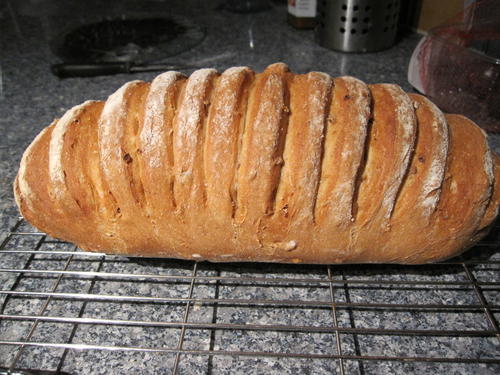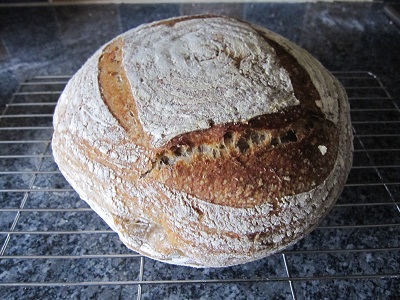OVERNIGHT WHITE LOAF BY HAND
This is a recipe and process for a basic but tasty Overnight White Loaf all made by hand to demonstrate how easy it is.
Why overnight? Because the very best bread, the most flavoursome bread is achieved through long periods of fermentation. Many people who make their own bread at home or whose mothers used to do so, will most likely make bread very quickly, mixing the ingredients and letting the dough rise for about 1-2 hrs then baking it. It’s just how people used to make basic bread at home. Nothing wrong with it, but it could be so much better. So in this recipe we make the dough late at night and leave it to ferment the entire night, up to 12 hrs and that develops flavour and structure.
Ingredients
Strong White Bread Flour - 500g
Salt - 5g
Fresh Baker’s Yeast - 1g to 2g
Water - 300g
Note that we weigh everything here. No measurements in ml or cups. You weigh everything in grams including the water.
Note also that I am using fresh baker’s yeast not instant yeast in packets. You can get fresh yeast from any Sainsbury’s. Ask at the bakery counter and ask for 100g of fresh yeast. It will cost just pennies. Fresh yeast imo gives a better result and flavour and is easy to work with.
Method
Begin late in the evening on Day 1 shortly before you go to bed. Let’s say it’s 9pm-10pm.
-
Weight the flour and salt in a large bowl
-
In a pyrex jug, weigh the 1g of fresh yeast
(This is a tiny amount about the size of a pea. Your scales may not register this small qty. It is fine if you end up with 2g.)
-
Tare your scales (zero them) with the jug and yeast on them and then pour in a little water and with a teaspoon mix the yeast so that it dissolves in the water
-
Now add more water until the scales read 300g
-
Pour the yeast water into the flour/salt and using a spatula or spoon stir everything together. Feel free to get your hands in and simply bring everything together until there is no loose flour left.
-
Cover the bowl with a large plate or tea towel and leave it for 10 mins. Good time to put the kettle on for a cuppa.
After the 10 mins is up, we are ready to begin the “kneading” process. It’s not really kneading in the traditional sense but it develops the dough nevertheless.
-
Leaving the dough in the bowl, use your fingers to pinch some of the dough at the outer edge, lift it up and then push it down into the middle of the dough ball. Rotate the bowl slightly, do another pinch and push into the middle. Rotate again and keep doing this until you have been all the way around the bowl. The entire thing should take about 10 seconds once you are used to it.
-
Cover the bowl again and leave for another 10 mins
Have that cuppa and read a paper.
-
We are now going to repeat the last 2 steps a total of 3 more times. So when the 10 mins is up, you do your pinch and folds around the bowls again, cover and leave for another 10 mins
In total then you should have done 4 lots of pinch and folds over a period of 40 mins. In that time you only handled the dough for about 40 seconds in total.
- Now cover the bowl and leave it out on the kitchen counter overnight.
Day 2
First thing next morning we will continue. The dough will have fermented overnight anywhere from 10-12hrs depending on when you got up. It will be bubbly and at least doubled in volume.
-
Flour your work surface lightly and tip the dough out. Try not to be rough and heavy at this stage. We want to preserve the airy bubbles that developed overnight.
-
Gently form the dough into the shape you want. A simple round boule is fine or you might choose a log.
I tend to favour not using a tin as I find free-form more fun and gives a more rustic looking loaf.
-
Transfer your shaped dough onto a baking sheet and leave it to rest a further 30 mins.
-
At the same time turn your oven on to 220-240 C and place a deep roasting tray in the bottom of it. Fill a mug with water and have it ready at the side of the oven.
-
When the 30 min rest is up we are ready to bake. Be very quick here so as not to loose the oven heat. In the space of a few seconds, open the oven door, put the loaf in and quickly empty the cup of water into the hot roasting tin in the bottom and quickly close the door.
The water will generate steam which will help to give the loaf more oven spring.
- Bake the loaf for about 25-35 mins or until it is golden brown. Every oven varies so just keep an eye on it towards the 25min mark
That’s it !
You should hopefully have a lovely sprung loaf that sounds hollow when you tap it on the bottom. Enjoy.
If you tried this then please post up pictures of your finished loaves. Good luck.




 I can make perfect soup in a large saucepan .
I can make perfect soup in a large saucepan .